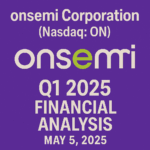AEye, Inc. (Nasdaq: LIDR)
Q1 2025 Financial Analysis | May 8, 2025
Executive Summary
AEye, Inc., a global leader in adaptive, high performance lidar solutions, reported Q1 2025 results with significant progress on key strategic milestones despite ongoing financial challenges. The company announced that its Apollo manufacturing line at LITEON is now operational, with B-sample deliveries to automotive OEMs expected during the second quarter of 2025. AEye also reached the final test stage of Apollo's integration into NVIDIA's DRIVE platform, positioning the product for widespread adoption in ADAS and autonomous driving platforms, while securing new customer agreements in the Intelligent Transportation Systems and Defense markets.
Q1 2025 Highlights
Financial Performance
AEye reported revenue of $64,000 for Q1 2025, a significant increase from $20,000 in Q1 2024, representing 220% year-over-year growth. While this revenue figure remains modest, it reflects the early commercialization stage of the company's lidar technology, with meaningful revenue growth expected as manufacturing of Apollo ramps up and market adoption increases.
GAAP net loss for the quarter was $8.0 million ($(0.46) per share), an improvement from the $10.2 million ($(1.61) per share) loss reported in Q1 2024. This 22% year-over-year reduction in net loss demonstrates the company's progress in controlling costs while advancing key strategic initiatives. On a non-GAAP basis, which excludes stock-based compensation, stock issuance and debt issuance costs, changes in fair value of convertible note and warrant liabilities, and gain on lease termination, net loss was $5.8 million ($(0.33) per share), compared to $7.2 million ($(1.13) per share) in Q1 2024.
Cash burn for Q1 2025 was $8.0 million, slightly higher than the $7.9 million reported in Q1 2024. Management expects cash burn to trend lower throughout 2025 as operational efficiencies continue to improve and the company progresses toward volume production. The company successfully raised additional capital during the quarter, with $11.4 million in net proceeds from financing activities, including $9.5 million from issuance of common stock and $2.4 million (net) from issuance of convertible notes.
AEye significantly improved its balance sheet strength by resolving lease litigation during the quarter, successfully reducing potential cash liability exposure from $6.4 million to $1.4 million. This resolution contributes to the company's improved financial position and reduced future cash obligations.
The company ended Q1 2025 with $25.9 million in cash, cash equivalents, and marketable securities, compared to $22.3 million at the end of Q4 2024. This increase reflects the success of recent financing activities, partially offset by operational cash burn. Management noted that the company's potential liquidity now stands at approximately $74 million when including available financial instruments, which provides runway to ramp Apollo for production at scale.
Product and Technology Development
AEye's Q1 2025 results highlighted significant progress in product development and manufacturing readiness, particularly for its flagship Apollo lidar system:
Key Technology Milestones
- Apollo Manufacturing Readiness: The Apollo manufacturing line at LITEON is now operational, marking a critical step toward mass production. B-sample deliveries to automotive OEMs are expected during the second quarter of 2025, representing an important milestone in the product's commercialization timeline.
- NVIDIA DRIVE Integration: Apollo has reached the final testing stage for integration into NVIDIA's DRIVE platform, positioning the product for widespread adoption in ADAS and autonomous driving platforms. This integration provides a significant opportunity for market expansion as NVIDIA's DRIVE platform is utilized by numerous automotive manufacturers and suppliers.
- Market Expansion: Apollo's capabilities are unlocking growth beyond automotive, with over 20 potential customer engagements progressing toward proof-of-concept deployments and revenue generation. The company secured new customer agreements in the Intelligent Transportation Systems and Defense markets, demonstrating the product's versatility and validating its capabilities across multiple applications.
AEye's technology differentiation continues to center around its adaptive, software-defined approach to lidar, which provides several advantages:
- Higher performance capabilities, including longer detection range and higher resolution
- Adaptability across multiple markets beyond automotive, including industrial, aerospace, and defense applications
- Software-configurable operation that can be updated and optimized for specific use cases without hardware changes
- Integration with AI and ML capabilities through platforms like NVIDIA DRIVE
The company's research and development expenses decreased to $3.5 million in Q1 2025 compared to $4.5 million in Q1 2024, reflecting a more focused approach to product development and the transition of Apollo from development to commercialization phase. Despite this reduction, AEye continues to advance its technology roadmap and prepare for next-generation lidar solutions beyond Apollo.
Strategic Initiatives
AEye's strategic focus continues to center around three key areas: automotive market penetration, expanding into adjacent markets, and scaling production capabilities through partnerships. The company made significant progress across all three areas during Q1 2025:
Automotive Market Strategy
The automotive sector remains AEye's primary target market, with the following strategic initiatives highlighted during Q1:
- NVIDIA DRIVE Integration: Entering the final testing phase for Apollo's integration into NVIDIA's DRIVE platform represents a critical milestone. This integration positions Apollo for adoption by automotive OEMs and Tier 1 suppliers who utilize NVIDIA's DRIVE platform for ADAS and autonomous driving applications.
- B-Sample Deliveries: With the Apollo manufacturing line now operational at LITEON, B-sample deliveries to automotive OEMs are expected in Q2 2025. These samples will enable potential customers to evaluate Apollo in real-world testing scenarios, representing an important step in the automotive qualification process.
- Tier 1 Partnerships: Continued collaboration with LITEON as a manufacturing partner exemplifies AEye's strategy of working with established Tier 1 suppliers to leverage their manufacturing expertise, quality systems, and automotive customer relationships.
Market Expansion Strategy
Beyond automotive, AEye is pursuing opportunities in adjacent markets where its lidar technology offers compelling advantages:
- Intelligent Transportation Systems (ITS): Secured new customer agreements in the ITS sector, where lidar can enhance traffic monitoring, intersection management, and infrastructure safety applications.
- Defense Applications: New customer agreements in the defense sector validate Apollo's capabilities for security, surveillance, and situational awareness in defense-related applications.
- Commercial Pipeline Growth: Over 20 potential customer engagements across multiple markets are progressing toward proof-of-concept deployments and revenue generation opportunities.
Operational Strategy
AEye continues to execute its capital-light business model focused on partnerships and operational efficiency:
- Manufacturing Partnership: Leveraging LITEON's manufacturing capabilities allows AEye to minimize capital expenditures while ensuring high-quality production.
- Cost Optimization: Resolution of lease litigation, reducing potential liability from $6.4 million to $1.4 million, demonstrates the company's focus on reducing operational costs and financial obligations.
- Capital Raising: Successfully raised $24 million over the past 14 months, including the financing activities in Q1 2025, providing runway for continued product development and commercialization.
CEO Matt Fisch emphasized the company's progress: "AEye hit several key milestones in the first quarter, paving the way for our future growth... Apollo's adaptability and unmatched range are opening doors in markets beyond automotive, helping us expand our pipeline as we engage new customers across a range of applications."
Business Outlook
AEye provided updated guidance for 2025, reflecting both recent progress and ongoing operational optimization:
2025 Financial Outlook
- Full-year 2025 cash burn expected to be in the range of $27 million to $29 million, an increase from the previously disclosed outlook of $25 million
- This increase reflects a one-time litigation settlement expense and the potential cash repayment of a portion of the outstanding convertible note
- Excluding these one-time costs, the underlying cash burn rate remains consistent with previous expectations
- Cash burn expected to trend lower throughout 2025 as operational efficiencies improve
Operational Outlook
- Apollo Production Ramp: B-sample deliveries expected to begin in Q2 2025, with production scaling throughout the year
- NVIDIA DRIVE Integration: Final testing phase in progress, with full integration expected to complete in 2025
- Customer Pipeline: Over 20 potential customer engagements progressing toward proof-of-concept deployments
- Market Expansion: Continued growth in automotive, ITS, and defense sectors expected throughout 2025
CFO Conor Tierney commented on the company's financial position: "Our potential liquidity now stands at approximately $74 million, which should provide us with the runway needed to ramp Apollo for production at scale. Backed by our capital-light model and resilient supply chain, we are well-prepared to navigate evolving global market dynamics while we capture new customer opportunities and expand Apollo's market share."
While AEye did not provide specific revenue guidance for 2025, the company's focus on commercialization and production ramp-up suggests potential for increased revenue generation in the latter part of 2025 and into 2026, particularly as Apollo B-samples reach automotive OEMs and other potential customers convert from proof-of-concept to commercial deployments.
Risks & Opportunities
Opportunities
Risks
Conclusion
Strengths
- Apollo manufacturing line operational at LITEON
- Advanced integration with NVIDIA DRIVE platform
- New customer agreements in ITS and defense markets
- Improved financial position with $25.9M cash balance
- Revenue increasing 220% YoY, albeit from a small base
Areas for Improvement
- Limited current revenue generation needs to accelerate
- Ongoing cash burn requiring additional financing
- Extended timeline to volume production and adoption
- Market adoption rates for lidar technology
- Competitive positioning against other lidar providers
Summary
AEye's Q1 2025 results demonstrate significant progress in product development, manufacturing readiness, and strategic partnerships, despite ongoing financial challenges. The company's Apollo lidar system has reached critical milestones, with the manufacturing line now operational at LITEON and integration with NVIDIA's DRIVE platform in the final testing stage. These achievements position Apollo for commercial adoption in automotive, ITS, and defense markets.
From a financial perspective, AEye continues to operate with limited revenue and ongoing cash burn, though improvements in operational efficiency and cost control are evident in the reduced net loss compared to the prior year. The company's cash position of $25.9 million, combined with additional potential liquidity sources, provides runway for continued execution of its commercialization strategy.
Looking forward, AEye's success will depend on converting its technological achievements and partnerships into meaningful revenue growth as Apollo moves from development to commercial deployment. The company's capital-light business model and focus on high-margin software components provide potential for profitability as volume scales, but near-term execution in B-sample deliveries and customer acquisition will be critical to building momentum in the competitive lidar market.
Source: AEye SEC Filings






